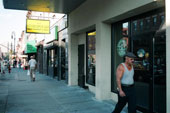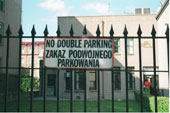PRESERVING POLAND IN BROOKLYN
If you didn’t know about the Polish and Slavic Center, you’d walk right past the gray stone chapel that is its home in Greenpoint, Brooklyn. The only clue about what actually goes on inside the weathered but sturdy structure is a modest sign that reads: “Centrum Polsko-Stowianskie.” Inside you find a showcase of Eastern European life. “At the center, you have Polish food, Polish tradition—it’s very ethnic,” Wiesliw Cybulski, a Greenpoint resident and retired mechanic, said. “It’s a nice place.” Cybulski, a political fugitive from Soviet Poland, fled communism and arrived in Atlanta, Georgia more than 25 years ago. He came to Greenpoint to re-connect with his past more than 10 years ago. “The Communists gave me one ticket, one way to Atlanta and told me never to come back. There was nothing Polish about Atlanta,” Cybulski said. “My friend told me people speak Polish here, so I came to Greenpoint.” Greenpoint, however, is transforming. The center is an entirely different world from Manhattan Avenue just one block up the street. Here, a Starbucks coffee shop sits next to a Polish meat market; a trendy Thai food restaurant is kitty corner to the Polish bakery; the construction site for new, expensive condominiums is just minutes away from this hub of Polish culture. But, in this small working class town where gentrification is the order of the day, the Polish community refuses to lose sight of its identity. “I don’t think I see any real changes in the Polish community,” Janusz Mlynek, the head coach of the Polish American Fencing School, said as one of his American-born students translated. “Only the storefronts change.” Mlynek lives in New Jersey, but commutes to the center several times a week to give fencing lessons to Polish children in Greenpoint. The center allows him to communicate with his students in his native language, so that they too will not lose touch with their heritage. “Most of my students live in Greenpoint, close to the center,” Mlynek said. “I only speak in Polish when I teach.” Cheap housing and an abundance of factory jobs made Greenpoint an important Polish and Italian immigrant enclave in the early 20th century. In 2005, however, zoning laws changed, allowing developers to build bigger, taller buildings. As a result, the looks of this northwest Brooklyn neighborhood have changed as well. Greenpoint’s location next to Williamsburg, as well as its proximity to the East River and Manhattan, has made it a hot spot for development. This means expensive real estate and new businesses that appeal to the changing community. Residents like Cybulski have their worries. “It’s much harder to live here now because of the money,” he said. “Everything is more expensive, even bread costs three times as much as it used to. It seems like everything is 10 times more expensive.” Still, college students flock here because rent is cheaper than in Manhattan. It’s still too soon to tell what affect the development boom of the past two-years will have on the working-class community here, but one thing is certain: prices are rising. Many Greenpoint residents, however, welcome the changes—particularly the addition of a Starbucks on Manhattan Avenue. “It’s a good thing—everybody likes Starbucks,” Bozena, the head of Immigration and Legal Services at the center, said. “If people like it, they can go.” Bozena deals with immigrants in her job daily. She still deals with a great deal of immigrants trying to get documentation, but the development changes and rising prices have changed this as well. “I deal with Polish, Czech Republic and Mexican immigrants mostly,” she said. “There are many immigrants coming into Greenpoint, but it’s a less percentage than 10 years ago.” For many of the Polish people in Greenpoint, the changes are inevitable. The center and the several blocks surrounding it are a safe haven for the Polish people. With programs that include judo, fencing, ballet and resources like a photography lab, free English language courses, and college scholarship programs that encourage young students to pursue a higher education, the Polish & Slavic Center helps keep the community unified. “We’re always eating Polish food and speaking to each other in Polish,” Cybulski said, preparing for a table tennis match. “There is always something going on—an anniversary, a birthday party, a holiday celebration. We’re always celebrating.”
|
The view from Manhattan Avenue in Greenpoint. The Starbucks sits next to the traditional Polish meat market.
|
|
The sign in front of the Polish and Slavic Federal Credit Union, writen in both Polish and English. |
|


